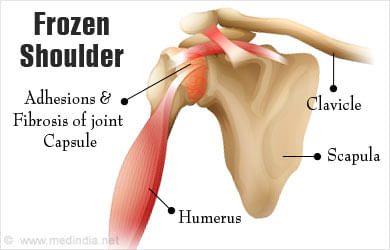Frozen Shoulder - How To Manage?
What Is Frozen Shoulder?
A frozen shoulder becomes stiff and painful, with limited range of motion. The space inside the shoulder joint slowly gets smaller. Frozen shoulder may take months to years to improve. A frozen shoulder develops in stages. In the fi rst stage (freezing), people notice shoulder pain and that it’s harder to move that arm. This stage usually lasts about 4 months. In the next 4 months, the shoulder stays very painful. It’s possible to move the arm only a little. This is known as being frozen. In the last stage, thawing, pain slowly goes away, and the arm can be moved again. This phase also lasts about 4 months in most cases.
What Causes Frozen Shoulder?
Causes of spontaneous frozen shoulder are unknown. A long period of immobilization, such as with wearing a sling or a cast after an injury, can cause it. Things that can increase chances of getting a frozen shoulder include long-term bed rest, shoulder injury, diabetes, stroke, Parkinson’s disease, and thyroid problems.
What Are the Symptoms of Frozen Shoulder?
Pain occurs throughout the shoulder area. The pain is in bones of the shoulder joint. Other nearby bones, including the scapula (shoulder blade) and clavicle (collarbone), can also be painful.
Pain can reach down into muscles of the upper arm. The pain occurs at the front and side of the shoulder. It’s constant, even at rest and at night. Besides the pain, movement becomes very limited. It becomes very hard to lift the arm.
How Is Frozen Shoulder Diagnosed?
The doctor makes a diagnosis from a physical examination. The doctor may order x-rays to rule out other illnesses that may cause symptoms. These conditions include degenerative arthritis, tumors, and shoulder dislocation.
How Is Frozen Shoulder Treated?
When frozen shoulder occurs without an injury or operation, conservative treatment with physical therapy is best. When it develops after shoulder surgery, more aggressive treatment, including more surgery, may be needed. The doctor can prescribe different treatments, including nonsteroidal antiinfl ammatory drugs (NSAIDs) for pain. Sometimes, stronger pain pills are ordered if NSAIDs don’t help. The key to recovery is to keep moving. Physical therapy, home exercises, and occupational therapy can be prescribed to relieve pain and maintain arm movement. Occupational
therapy helps continue normal activities. The doctor may inject steroids into the joint itself. Very rarely, surgery or manipulation of the shoulder may be needed.After recovery, frozen shoulder usually won’t occur in the same shoulder. Sometimes the other shoulder can become frozen.
DOs and DON’Ts in Managing Frozen Shoulder:
✔ DO take pills as your doctor directs.
✔ DO follow all instructions from the physical and occupational therapists.
✔ DO exercises as instructed.
✔ DO call your doctor if you have symptoms that worry you.
✔ DO call your doctor if you have shoulder pain that doesn’t respond to rest and is related to decreased range of motion of the shoulder joint.
✔ DO use and move your shoulder normally. A frozen shoulder often follows periods of lack of use, or immobility, in a shoulder.
- DON’T forget to do exercises.
- DON’T stop your physical therapy without talking to your doctor.





+1.svg)
